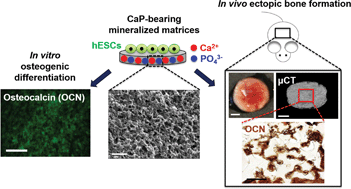Biomineralized matrix-assisted osteogenic differentiation of human embryonic stem cells†
Abstract
The physical and chemical properties of a matrix play an important role in determining various cellular behaviors, including lineage specificity. We demonstrate that the differentiation commitment of human embryonic stem cells (hESCs), both in vitro and in vivo, can be solely achieved through synthetic biomaterials. hESCs cultured using mineralized synthetic matrices mimicking a calcium phosphate (CaP)-rich bone environment differentiated into osteoblasts in the absence of any osteogenic inducing supplements. When implanted in vivo, these hESC-laden mineralized matrices contributed to ectopic bone tissue formation. In contrast, cells within the corresponding non-mineralized matrices underwent either osteogenic or adipogenic fate depending upon the local cues present in the microenvironment. To our knowledge, this is the first demonstration where synthetic matrices are shown to induce terminal cell fate specification of hESCs exclusively by biomaterial-based cues both in vitro and in vivo. Technologies that utilize tissue specific cell–matrix interactions to control stem cell fate could be a powerful tool in regenerative medicine. Such approaches can be used as a tool to advance our basic understanding and assess the translational potential of stem cells.



 Please wait while we load your content...
Please wait while we load your content...